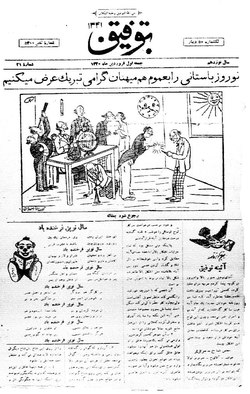Top Qs
Timeline
Chat
Perspective
Towfigh
Iranian political and satirical weekly magazine (1923–1971) From Wikipedia, the free encyclopedia
Remove ads
Towfigh, also known as Tawfiq, (Persian: توفیق) was a weekly satirical magazine which was published between 1923 and 1971 in Tehran, Iran, with some interruptions. It was among the critics of the Pahlavi rule.[1]
The journal went through three phases: from 1923 until 1939, under founding editor Hossein Towfigh the magazine was more nationalistic; from 1941 until 1953, under the son Mohammad-Ali Towfigh, the magazine was more politically and government-critical; and later versions of the magazine, under Towfigh brothers Hassan, Hossein, and Abbas, focused on pure satire.[2]
Remove ads
History
Towfigh was launched in 1923 as a four-page weekly.[2][3] However, there are other reports giving its foundation date as 1922.[4][5] The headquarters of the magazine was in Tehran.[3] Its founder was the Iranian journalist Hossein Towfigh who edited the magazine until his death in 1939.[3] During his editorship the magazine ceased publication between 1932 and 1938.[3]
He was succeeded by his son Mohammad Ali Towfigh as editor, who restarted the publication in 1941.[3][6] In 1949 the magazine was banned following the frequent publication of cartoons mocking Prime Minister Abdolhossein Hazhir.[7] Mohammad Ali Towfigh edited Towfigh until 1953 when the magazine was again closed down by the Iranian authorities after the overthrow of the government of Prime Minister Mohammad Mosaddegh.[3][6]
It was restarted on 20 March 1958 with the title Fokāhi (Persian: Humorous).[3] Later it began to be published under its original title and was edited by three nephews of Hossein Towfigh (named Hassan, Hossein and Abbas Towfigh).[2][3] One of its frequent targets was Prime Minister Amir-Abbas Hoveyda[5] who was instrumental in its closure by the censorship agency in 1971.[8]
Remove ads
Content, contributors and political stance
Summarize
Perspective
Towfigh had a changing political stance throughout its existence. It targeted and expressed the political views of lower- and middle-class Iranians.[4] Its contributors were liberal and secular writers and artists.[4] Major contributors included Abolqasem Halat, Abbas Forat, Iraj Pezeshkzad, Parviz Khatibi, Manouchehr Mahjoubi, Omran Salahi, Manouchehr Ehterami, Kioumars Saberi Foumani, Kambiz Derambakhsh and Naser Pakshir.[6] Hadi Khorsandi started his journalistic career in the magazine which contributed to when he was a high school student.[9]
The magazine featured political caricatures which appeared five years after its start when the Iranian government allowed their publication.[3] These cartoons mostly attacked the members of the Pahlavi dynasty in a covert manner to avoid censorship.[4] From 1938 the magazine began to contain literary material instead of political satire due to the strict censorship exerted by the government.[3] Following the abdication of Reza Shah in 1941 Towfigh continued to publish political cartoons and political satire until its closure in 1971.[3] In these satirical materials the Shah, Mohammad Reza Pahlavi, prime ministers and cabinet members were criticized for their alleged inefficiency and incompetency.[7]
Remove ads
Legacy
The Chicago Persian Microfilms Project initiated by the University of Chicago in 1985 archived the issues of Towfigh.[10]
Towfigh cover pages
References
External links
Wikiwand - on
Seamless Wikipedia browsing. On steroids.
Remove ads


